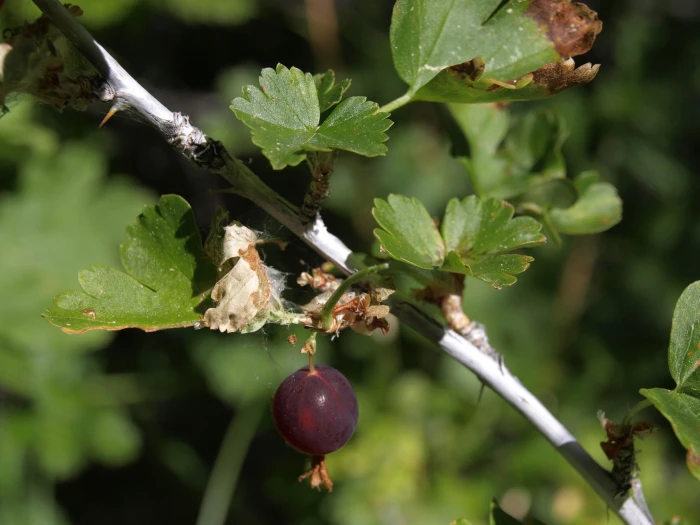Whitestem Gooseberry
(Ribes inerme)
Whitestem Gooseberry (Ribes inerme)
/
/

Jim Morefield
CC BY 4.0
Image By:
Jim Morefield
Recorded By:
Copyright:
CC BY 4.0
Copyright Notice:
Photo by: Jim Morefield | License Type: CC BY 4.0 | License URL: http://creativecommons.org/licenses/by/4.0/ | Rights Holder: Jim Morefield | Publisher: iNaturalist | Date Created: 2016-08-01T09:48:22-07:00 |
























Estimated Native Range
Climate Requirements for Killeen, Texas
| This Plant | Your Site | Plant Suitability for Your Location | ||
|---|---|---|---|---|
| • Precipitation | 9" - 79" | 31" | Your precipitation may be too high for this plant. | Too high |
| • High Temp. | 59°F - 93°F | 96°F | Your summers may be too hot for this plant. | Too hot |
| • Low Temp. | -11°F - 41°F | 35°F | Your winter temperatures are normal for this plant | Excellent |
This plant may not grow well at your location - your precipitation is too high.
Summary
Ribes inerme, commonly known as Whitestem Gooseberry, is a deciduous shrub native to the western regions of North America, including British Columbia, California, and extending eastward to the Rocky Mountains. It is typically found in a variety of habitats such as stream banks, moist mountain forests, woodlands, and meadows, often in areas with cool, moist conditions. This shrub can reach up to 10 feet in height and has an erect or spreading habit with hairless or bristly stems that bear spines at the nodes. The leaves are palmately lobed, typically divided into three to five toothed lobes. Whitestem Gooseberry produces an inflorescence of up to five flowers, each with reddish-green sepals and white or pinkish petals, blooming from April to July. The flowers are modest in showiness. The edible fruit is a hairless berry that can be greenish, purple, or black when ripe.
In cultivation, Whitestem Gooseberry is valued for its wildlife-friendly attributes, as it provides food for birds and other animals. It is used in naturalistic plantings, such as in wildlife gardens or as part of a hedgerow. This shrub is adaptable to a range of soil types, provided they are well-drained, and it can tolerate both full sun and partial shade. While it is relatively low-maintenance, it may require some pruning to control its spread and to remove dead or diseased wood. Gardeners should be cautious as the spines can make handling difficult. There are no major disease problems, but the plant can be susceptible to powdery mildew and rust.CC BY-SA 4.0
In cultivation, Whitestem Gooseberry is valued for its wildlife-friendly attributes, as it provides food for birds and other animals. It is used in naturalistic plantings, such as in wildlife gardens or as part of a hedgerow. This shrub is adaptable to a range of soil types, provided they are well-drained, and it can tolerate both full sun and partial shade. While it is relatively low-maintenance, it may require some pruning to control its spread and to remove dead or diseased wood. Gardeners should be cautious as the spines can make handling difficult. There are no major disease problems, but the plant can be susceptible to powdery mildew and rust.CC BY-SA 4.0
Plant Description
- Plant Type: Shrub
- Height: 5-6 feet
- Width: 2-4 feet
- Growth Rate: Moderate
- Flower Color: Cream, Green, Pink, White
- Flowering Season: Spring, Summer
- Leaf Retention: Deciduous
Growth Requirements
- Sun: Full Sun, Part Shade
- Water: Medium
- Drainage: Fast, Medium
Common Uses
Bee Garden, Bird Garden, Butterfly Garden, Low Maintenance, Potted Plant
Natural Habitat
Native to stream banks, moist mountain forests, woodlands, and meadows in western North America
Other Names
Common Names: Spreading Gooseberry, Whitestem Gooseberries, White-Stemmed Gooseberry
Scientific Names: Ribes inerme, Grossularia inermis, Grossularia inermis f. puberula, Grossularia inermis f. pubescens, Grossularia inermis var. pubescens, Ribes divaricatum var. inerme, Ribes divaricatum var. inerme, Ribes hirtellum subsp. purpusii, Ribes hirtellum subsp. purpusii
GBIF Accepted Name: Ribes inerme